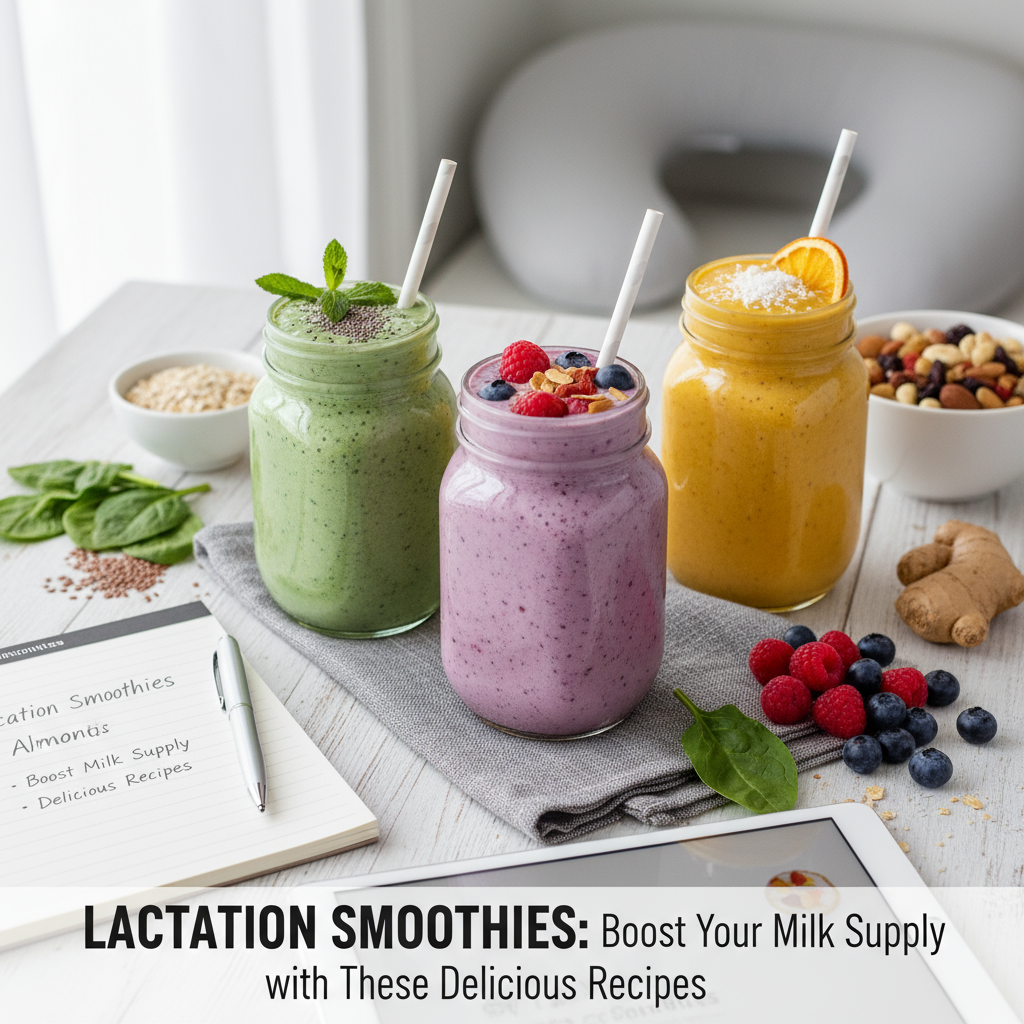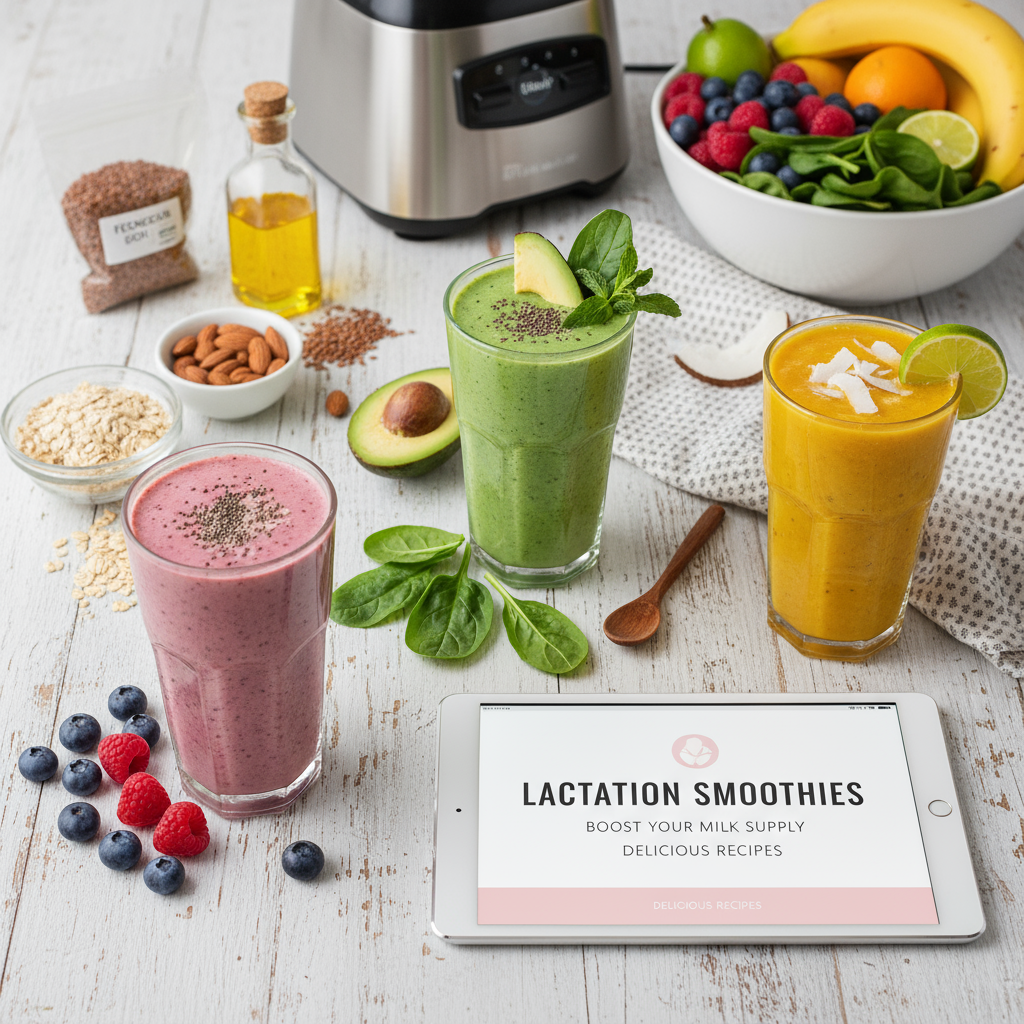
Lactation Smoothies: Boost Your Milk Supply with These Delicious Recipes
For breastfeeding moms who want a simple, tasty way to nudge supply up without living in the kitchen, this guide is for you. You’re juggling cluster feeds, pumping schedules, maybe going back to work, and those 2 a.m. hunger pangs—while wondering, “Is my milk enough?” and “What can I snack on that actually helps?” Our lactation nutrition team specializes in evidence-based breastfeeding recipes and practical plans (we’ve worked with 1,000+ families), so we’ll show you exactly how to use lactation smoothies to increase milk supply—without gimmicks, without overwhelm. Learn more about lactation nutrition team.
Lactation Smoothies: Do They Really Increase Milk Supply?
Short answer: they can help—when used the right way. A well-built lactation smoothie supports the three pillars of milk production: calories, hydration, and consistent removal (nursing or pumping). The “galactagogue” ingredients you’ve heard about—oats, barley, flax, brewer’s yeast, dates, moringa—may nudge supply for some parents. But the biggest wins usually come from hitting your energy needs and protein targets day after day.
Why? Because breastmilk is made from what you eat and drink and how often milk is removed. If your body’s short 400–500 calories, or you’re under-hydrated, supply can dip. A smart smoothie can cover 350–650 calories, 20–35 g protein, and a lot of fluids in one cup. That’s leverage.
Real talk: if latch, pump fit, or schedule is off, no smoothie beats biology. So pair these recipes with solid feeding mechanics. Learn more about solid feeding mechanics. If that piece feels messy, our IBCLC partners can assess latch and flange size while we dial in your nutrition—so you’re not guessing. Learn more about assess latch and flange size.
Which Ingredients Increase Milk Supply? (Evidence-Based)
I’ve noticed the same handful of ingredients popping up in the most effective breastfeeding recipes. Some have stronger data than others, but together they create a nutrient-dense base that supports output and energy.
Oats and Barley (Beta-Glucans)
Oats and barley contain beta-glucans that may increase prolactin—the hormone that drives milk production. Oat-based lactation smoothies are popular for a reason: they’re filling and easy to digest at 6 a.m. when you need something quick. Steel-cut, rolled, or even cooked and cooled oats work. Barley adds a mild, slightly sweet flavor and blends smoothly when cooked.
Flaxseed and Chia (Healthy Fats + Fiber)
Ground flaxseed brings ALA omega-3s and gentle phytoestrogens that may support supply in some parents. Chia seeds add fiber and thickens a smoothie (so satisfying), while electrolytes help with hydration.
Brewer’s Yeast (B-Vitamins)
Brewer’s yeast shows up in lots of lactation smoothies and cookies. It’s rich in B-vitamins and minerals; evidence is mixed on direct supply impact, but many moms report feeling more energized. Start small—about 1 teaspoon—since taste can be strong.
Dates (Easy Calories + Minerals)
Dates are a smart way to add calories, iron, and potassium without refined sugar. They blend silky-smooth and keep blood sugar steadier than syrups. Two to three Medjool dates create a milkshake vibe.
Moringa (Malunggay) Leaf
Moringa is one of the few galactagogues with a handful of small randomized trials showing increased milk volume in the early postpartum period. Use a reputable powder (about 1 teaspoon to start). The taste is green—pair with pineapple or mango.
Fennel and Anise
Traditional galactagogues in many cultures. Fennel offers a light licorice note; you can use fresh bulb or a pinch of seeds (or tea that’s cooled). Works surprisingly well with green apple.
Fenugreek (Use With Caution)
Some people see a boost; others see GI upset or even a dip in supply. It can interact with thyroid issues and meds. If you’re curious, start low (¼–½ teaspoon) or skip it. There’s no “must” ingredient for lactation smoothies.
Protein and Healthy Fats
Protein (20–30 g) and fats (nut butters, avocado, coconut) help you feel full and maintain a stable supply through growth spurts. Whey or plant proteins both work—just pick a clean, low-additive option.
Fluids + Electrolytes
Milk is mostly water. Smoothies that include coconut water, milk, or Greek yogurt deliver both hydration and electrolytes—handy on hot days or after a sweaty stroller walk.
When’s the Best Time to Drink a Lactation Smoothie?
Here’s the playbook we use with clients:
- Morning after the first feed or pump: sets your calorie and fluid base for the day.
- 30–60 minutes before a pumping session: gives a quick energy bump and hydration boost.
- During growth spurts (day 10-ish, week 3, week 6, months 3 and 6): steady intake helps you keep up with demand.
- Night snack if you’re waking hungry: a smaller, protein-heavy smoothie can stabilize overnight supply.
How often? Start with 1 smoothie daily for 7 days. Track output. If you’re exclusively pumping or rebuilding supply, 2 smoothies can help (one high-calorie, one lighter).
Top 11 Lactation Smoothie Recipes to Increase Milk Supply
Each recipe includes ingredients, quick directions, why it helps, and approximate nutrition. Tweak sweetness with dates or frozen fruit. And yes—blend time matters: 45–60 seconds produces that creamy café texture.

1) Oatmeal Cookie Latte Lactation Smoothie
Ingredients:
- 1 cup milk or fortified plant milk
- ½ cup cooked rolled oats (cooled)
- 1 frozen banana
- 1 tablespoon almond butter
- 1 teaspoon brewer’s yeast
- 1 teaspoon vanilla
- Pinch cinnamon + pinch sea salt
- Optional: 2–3 ice cubes or ¼ cup cold-brew (decaf if sensitive)
Directions: Blend until silky. Taste, then add 1 date if you want it sweeter.
Why it helps: Oats + brewer’s yeast + balanced carbs/protein. It tastes like a cookie, not a chore.
Approx. nutrition: ~410 calories, 19 g protein.
2) Berry-Spinach Flax “Milk Maker”
Ingredients:
- 1 cup kefir or Greek yogurt + ¼ cup water
- 1 cup frozen mixed berries
- 1 cup baby spinach
- 1 tablespoon ground flaxseed
- 1 tablespoon honey or 2 dates
- ½ teaspoon vanilla
Directions: Blend greens and liquid first, then add the rest.
Why it helps: Flax for fats, berries for vitamin C, probiotic base for gut health (and fewer 3 a.m. tummy woes).
Approx. nutrition: ~360 calories, 24 g protein.
3) Chocolate Peanut Butter Brewer’s Yeast Shake
Ingredients:
- 1½ cups milk
- 1 scoop chocolate protein (20–25 g)
- 1 tablespoon peanut butter
- 1 teaspoon brewer’s yeast
- 1 tablespoon cocoa powder
- 1 small frozen banana
- Pinch salt
Directions: Blend on high 45 seconds. Add 2 ice cubes for froth.
Why it helps: High-protein, satisfying, delivers B-vitamins without tasting “yeasty.”
Approx. nutrition: ~520 calories, 34 g protein.
4) Tropical Moringa Milk Boost
Ingredients:
- 1 cup coconut water
- ½ cup coconut milk (carton or light canned)
- 1 cup frozen mango
- ½ cup frozen pineapple
- 1 teaspoon moringa powder
- 1 tablespoon chia seeds
- ½ lime, juiced
Directions: Blend, rest 2 minutes (chia thickens), quick re-blend.
Why it helps: Moringa has supportive data; electrolytes for hydration in hot weather.
Approx. nutrition: ~380 calories, 9 g protein.
5) Almond Date “Milk & Honey” Smoothie
Ingredients:
- 1 cup unsweetened almond milk
- 3 Medjool dates, pitted
- 2 tablespoons rolled oats
- 2 tablespoons plain Greek yogurt
- 1 tablespoon almond butter
- ¼ teaspoon cinnamon
Directions: Soak dates in warm water 5 minutes if hard, then blend all.
Why it helps: Easy calories and minerals from dates; gentle on sensitive stomachs.
Approx. nutrition: ~430 calories, 17 g protein.
6) Pumpkin Pie Power (Seasonal Favorite)
Ingredients:
- 1 cup milk
- ½ cup pumpkin puree
- ¼ cup cooked oats
- 1 scoop vanilla protein
- 1 tablespoon ground flaxseed
- ¾ teaspoon pumpkin pie spice
- 1–2 teaspoons maple syrup
- Ice to preference
Directions: Blend until creamy. Top with a dusting of spice—because joy matters.
Why it helps: Oats + flax + protein, perfect for fall when you’re craving cozy flavors.
Approx. nutrition: ~410 calories, 29 g protein.
7) Green Apple Fennel Refresher
Ingredients:
- ¾ cup kefir or yogurt
- ½ cup cold fennel tea or water
- 1 green apple, chopped (skin on)
- ½ cup cucumber
- ½ avocado
- 1 teaspoon lemon juice
- Small pinch fennel seeds (optional, strong!)
Directions: Blend smooth; add extra water for a lighter sip.
Why it helps: Fennel is a traditional galactagogue; avocado adds satisfying fats.
Approx. nutrition: ~360 calories, 14 g protein.
8) PB&J Lactation Smoothie
Ingredients:
- 1 cup milk
- 1 cup frozen strawberries
- 2 tablespoons rolled oats
- 1 tablespoon peanut butter
- 1 tablespoon chia seeds
- 1 teaspoon vanilla
Directions: Blend, then let it sit 1 minute so chia gels a bit—old-school PB&J vibes.
Why it helps: Oats + chia + peanut butter = carbs, fiber, and fats that stick with you.
Approx. nutrition: ~420 calories, 18 g protein.
9) Mocha Milk Maker (Decaf-Friendly)
Ingredients:
- 1 cup milk
- ½ cup cooled coffee (decaf or regular within your caffeine limit)
- 1 scoop chocolate protein
- 1 tablespoon cocoa powder
- 1 teaspoon brewer’s yeast
- 1 date
- Ice
Directions: Blend until frothy like a café drink—minus the long line.
Why it helps: Protein forward with B-vitamins from brewer’s yeast; feels indulgent.
Approx. nutrition: ~330 calories, 28 g protein.
10) Freezer “Lactation Cubes” for 60-Second Smoothies
Prep once, blend for days:
- In a blender: 2 cups cooked oats, 6 dates, 2 bananas, 2 tablespoons flaxseed, 2 teaspoons vanilla, 1½ cups milk—blend.
- Freeze in silicone trays. Pop 6–8 cubes per smoothie with 1 cup milk + 1 scoop protein.
Why it helps: Meal-prep magic for busy weeks or the back-to-work transition.
Approx. nutrition (per finished smoothie): ~480 calories, 30 g protein.
11) Exclusive-Pumper Power Shake (High-Calorie)
Ingredients:
- 1½ cups milk
- 1 scoop plain or vanilla whey/pea protein
- ½ cup cooked barley (cooled)
- 1 banana
- 2 tablespoons almond butter
- 1 tablespoon ground flaxseed
- 1 teaspoon honey
- Pinch salt
Directions: Blend 60 seconds. It’s thick—add ¼ cup water if needed.
Why it helps: Dense calories for those pumping 7–8 times daily and struggling to keep up.
Approx. nutrition: ~640 calories, 36 g protein.
Healthy Breastfeeding Snacks That Pair With Smoothies
Look, smoothies are clutch—but you’ll still need grab-and-go bites. Pairing one smoothie with 2–3 healthy breastfeeding snacks across the day steadies energy and supply.
- Greek yogurt + ¼ cup granola and blueberries
- Whole-grain toast with avocado, hemp seeds, and a squeeze of lemon
- Hard-boiled eggs with everything seasoning
- Hummus with carrots, cucumbers, and whole-grain crackers
- Apple slices with almond butter and cinnamon
- Trail mix: almonds, cashews, pumpkin seeds, dark chocolate chips (⅓ cup)
- Cheese stick + pear
- Oatmeal cup with milk, flax, and honey (2 minutes in the microwave)
How to Customize Lactation Smoothies for Your Diet
Everybody’s different. Here’s how to tweak without losing supply-supporting benefits.
Dairy-Free or Vegan
- Use fortified soy milk for the highest protein (8 g per cup) or pea milk.
- Swap Greek yogurt with coconut yogurt plus a scoop of plant protein.
- Choose plant proteins with 20–25 g per scoop; check for minimal gums/sweeteners.
Gluten-Free
- Use certified gluten-free oats and skip barley. Quinoa flakes are a solid sub.
Low-Sugar / Gestational Diabetes History
- Keep fruit to 1 cup and pair with protein and fats.
- Use dates sparingly (1–2) or omit and add cinnamon + vanilla for flavor.
- Aim for 25–35 g protein per smoothie to blunt glucose spikes.
Nut-Free
- Swap nut butters for sunflower seed butter or tahini.
- Use oat milk or dairy milk for creaminess.
Common Mistakes That Can Stall Milk Supply
Let’s be blunt so you don’t waste time.

- Relying on smoothies without fixing milk removal. Supply responds to demand. If a pump session gets skipped, no amount of oats will counter it.
- Not eating enough. I’ve seen parents running on 1,600 calories and wondering why supply dipped. Most breastfeeding parents need at least 2,000–2,400 depending on size and activity.
- Overdoing fenugreek. It can backfire for some people (and mess with sensitive stomachs).
- Using too little protein. A 120-calorie fruit smoothie is a snack, not a supply supporter.
- Dehydration—especially during heat waves. Add coconut water or a pinch of salt to your smoothie on sweaty days.
- Ignoring pump fit. If flanges are off by 2 mm, output suffers. If this is you, our team can measure and match flanges while we refresh your smoothie plan.
Meal Prep: Can I Make Lactation Smoothies Ahead?
Yes—batching buys you sanity. Here’s how to hit the ground running:
- Prep smoothie bags: freeze fruit, oats, and greens in 10 zipper bags. In the morning, dump into the blender with milk/protein.
- Make 12 lactation cubes (see recipe #10). They blend from frozen in under 60 seconds.
- Pre-mix dry boosters (flax, brewer’s yeast, chia) into a small jar. 1 tablespoon per smoothie.
- Keep shelf-stable milk or UHT cartons in your pump bag for emergency fuel.
Quick Answers to High-Intent Questions
Do lactation smoothies work fast?
Sometimes you’ll notice fuller breasts within 24–72 hours, especially if you were under-eating or dehydrated. But the biggest gains show up over 7–10 days when you pair smoothies with frequent nursing/pumping (8–12 removals in early weeks, 6–8 later). Consistency wins.
How many lactation smoothies per day should I drink?
Start with 1 daily. If you’re exclusively pumping or rebuilding supply after illness or travel, 2 can help—one around morning, one pre-pump mid- afternoon. Track output; adjust if weight gain or output stalls the other direction.
Are lactation smoothies safe while breastfeeding?
Yes—if you’re using common foods (oats, fruit, milk, flax) and paying attention to any ingredient sensitivities for you or baby. Avoid mega-dosing herbal powders. If your baby shows new gassiness or rash, pause and reintroduce ingredients one by one.
Do I need fenugreek in my smoothie?
No. Plenty of people increase milk supply without fenugreek. If you choose to try it, start very small and discontinue if you notice GI issues or a drop in output. Moringa, oats, and simply more calories are solid alternatives.
Are smoothies better than lactation cookies?
Different tools. Smoothies pack protein, fluids, and micronutrients in one go. Cookies are convenient but often lower in protein and higher in sugar. If you love cookies, great—just pair them with yogurt or milk and keep smoothies as your daily anchor.
Your Next Steps (So You Actually See Results)
Pick 2 recipes and make them on repeat for 7 days—one protein-forward (like #3 or #11) and one lighter hydration option (like #4). Drink the first within 90 minutes of waking and the second 30–60 minutes before a pump. Jot down your pump volumes or diaper counts—numbers don’t lie. If the nutrition piece feels like one more spinning plate, our lactation nutrition team can batch-plan your smoothies and snacks for you while a lactation consultant fine-tunes your feeding routine. Simple, doable, done.





